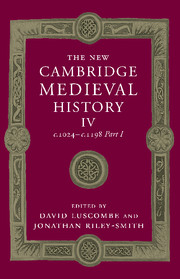Book contents
- Frontmatter
- 1 Introduction
- 2 The Rural Economy and Demographic Growth
- 3 Towns and the Growth of Trade
- 4 Government and Community
- 5 The Development of Law
- 6 Knightly Society
- 7 War, Peace and the Christian Order
- 8 The Structure of the Church, 1024–1073
- 9 Reform and the Church, 1073–1122
- 10 Religious Communities, 1024–1215
- 11 The Institutions of the Church, 1073–1216
- 12 Thought and Learning
- 13 Religion and the Laity
- 14 The Crusades, 1095–1198
- 15 The Eastern Churches
- 16 Muslim Spain and Portugal: Al-Andalus and its Neighbours
- 17 The Jews in Europe and the Mediterranean Basin
- 18 Latin and Vernacular Literature
- 19 Architecture and the Visual Arts
- List of Primary Sources
- Bibliography of secondary works arranged by chapter
- Index
- Frontispiece">
- Plate section"
1 - Introduction
Published online by Cambridge University Press: 28 March 2008
- Frontmatter
- 1 Introduction
- 2 The Rural Economy and Demographic Growth
- 3 Towns and the Growth of Trade
- 4 Government and Community
- 5 The Development of Law
- 6 Knightly Society
- 7 War, Peace and the Christian Order
- 8 The Structure of the Church, 1024–1073
- 9 Reform and the Church, 1073–1122
- 10 Religious Communities, 1024–1215
- 11 The Institutions of the Church, 1073–1216
- 12 Thought and Learning
- 13 Religion and the Laity
- 14 The Crusades, 1095–1198
- 15 The Eastern Churches
- 16 Muslim Spain and Portugal: Al-Andalus and its Neighbours
- 17 The Jews in Europe and the Mediterranean Basin
- 18 Latin and Vernacular Literature
- 19 Architecture and the Visual Arts
- List of Primary Sources
- Bibliography of secondary works arranged by chapter
- Index
- Frontispiece">
- Plate section"
Summary
taken together, the eleventh and twelfth centuries are a unique fulcrum in the development of the medieval world. The relations between Latin Christendom, the Scandinavian world, the Byzantine empire and the world of Islam underwent immense and sometimes conclusive changes in this period, and the development of Europe, let alone of western Europe, cannot be studied in isolation from that of her neighbours with whom there was increasing interaction. Throughout this volume we have tried to take a broad view of what mattered in the relationships not only between western and eastern Europe, but also between Europe, North Africa and the Middle East.
In order to attempt to account for the comprehensive changes and growth that took place over this long period, differing kinds of discussions and numerous chapters are required. This fourth volume of the the New Cambridge Medieval History has two parts which are each of a length comparable with the other volumes in this series. They are complementary to each other rather than sequential: Part 1 focuses mainly on themes – themes in economic, social, governmental, ecclesiastical and cultural history – while Part 2 gives more attention to government on a territorial or institutional basis.
In 1025, the year of the death of the emperor Basil II, Byzantium was at the height of its power and had achieved its greatest territorial extent. Its empire stretched from the Adriatic to the Caucasus, from the south of the Peloponnese to the Gulf of Finland. Eastern Europe was linked to northern Europe by a network of links in which the Vikings played a great part.
Keywords
- Type
- Chapter
- Information
- The New Cambridge Medieval History , pp. 1 - 10Publisher: Cambridge University PressPrint publication year: 2004

